When it comes to China, you may not have heard of the Yangtze River Delta, but you must have heard of Shanghai and Yiwu. Shanghai is the economic and financial center of China, just like New York in the United States.
Yiwu is known as the ‘supermarket’ of the world. It has an international sourcing center, and the small goods here are sold to more than 230 countries and regions around the world. These two cities are located in the Yangtze River Delta that I am going to introduce to you today.
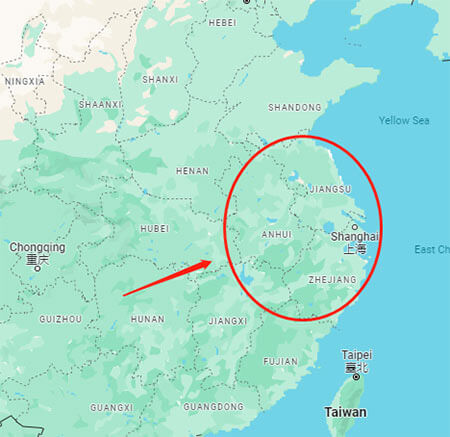
1. Where is the Yangtze River Delta?
Located in the southeast coast of China, the Yangtze River Delta is an estuarine plain formed by sediment deposition caused by the slowing down of the Yangtze River, the longest river in China. The terrain is flat and low-lying, and the soil is fertile, so agriculture here was developed in the past.
The Yangtze River Delta region mainly includes the municipality of Shanghai, and the three provinces of Jiangsu, Zhejiang, and Anhui (China’s provinces are similar to the states of the United States, but the names of the two are different).
The total area is 350,000 square kilometers, which is about the size of Germany. With the exception of Anhui, the other three places are all located on the coast, with a total coastline length of more than 3,000 kilometers.
2. Why the Yangtze River Delta is the best in China's economy?
After China shifted from overland trade to maritime trade, the Yangtze River Delta became China’s first open trading port from 1842. By the Qing Dynasty, it was from here that large quantities of Chinese porcelain and tea were shipped around the world.
In the 20th century, affordable industrial goods from China started making their way to the world. Since the Yangtze River Delta region is located at the mouth of the Yangtze River, there are many large ports and developed shipping.
Moreover, its flat terrain, dense railway and road networks, and extensive river system made transportation incredibly convenient. Many goods in Chinese mainland will be transported to the ports of the Yangtze River Delta by land or water.
Gradually, Chinese factories moved here, forming dense industrial belts. For example, for an electric car, you don’t need to leave the Yangtze River Delta,you can basically find upstream and downstream material parts suppliers here, which greatly improves production efficiency.
Now the Yangtze River Delta is the most developed region in China, contributing over 20% to the country’s GDP year-round. Its share of total imports and exports exceeds one-third of China’s. The per capita income here is 1.5 times higher than the national average. In terms of economic status, technology, culture, and education, this region holds a leading position in China.
3. What products are produced in Yangtze River Delta?
The Yangtze River Delta has a large population and abundant workforce. Its industrial development started early, and traditional industries such as textiles, food, chemical, and engineering machinery are well-developed.
In recent years, high-tech industries have also grown rapidly, leading the country in new energy (such as electric vehicles, solar cells, lithium batteries), electronic information (such as integrated circuits), biopharmaceuticals, and artificial intelligence.
At the same time, different areas within the Yangtze River Delta have their own distinctive industries. Below, we’ll specifically outline some of the key industries in the three provinces and one municipality.
Shanghai
Shanghai’s GDP is driven by the service sector, contributing over 70% to its total economic output. It serves as China’s economic, financial, and technological hub.
Currently, traditional heavy industries in Shanghai, such as chemical, steel, and equipment manufacturing, are shifting to other regions in China, leading to a significant decrease in the proportion of heavy industry.
However, high-tech industries like new energy vehicles and computer electronics continue to be at the forefront nationwide.
Automobiles
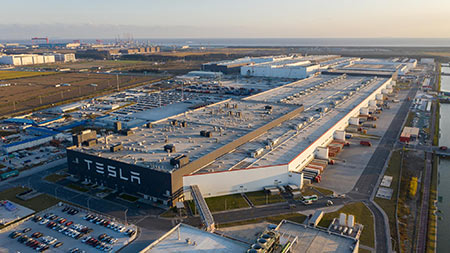
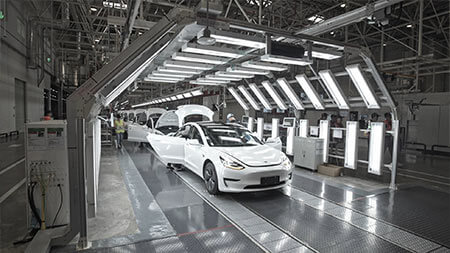
Shanghai’s automobile industry is well developed, gathering many world-famous automobile companies and auto parts groups such as Tesla and SAIC. Shanghai’s new energy vehicle exports are huge, accounting for more than 20% of China’s total automobile exports, mainly exported to the United Kingdom, Belgium, Thailand, the Philippines, Australia and other countries.
Electronic information products
Shanghai is an important production area for electronic information products such as integrated circuits and microcomputers. Shanghai’s integrated circuit production accounts for 10.2% of China’s output, and the industrial scale accounts for 1/4 of China’s, gathering a number of leading enterprises, such as Primarius Electronics, S2C, Shanghai Advanced Silicon and so on.
Biomedical products
Shanghai has more than 6,000 biopharmaceutical-related companies, including internationally renowned pharmaceutical companies such as Novartis, Pfizer and Medtronic, accounting for 1/5 of the country’s industrial scale.
It mainly exports antibiotic drugs, physical and chemical analysis instruments and other pharmaceutical products, and the products are sold to the United States, Germany, India, Japan and other places.
Jiangsu
Jiangsu’s light and heavy industries are relatively developed, of which the heavy manufacturing industry is mainly concentrated in southern Jiangsu. Electronic products, machinery, chemicals, appliances, automobile manufacturing and metal smelting are the pillar industries of Jiangsu. Light industries include textiles, furniture, etc.
Major export products include mechanical and electrical products, high-tech products, automatic data processors and accessories, clothing and accessories, etc.
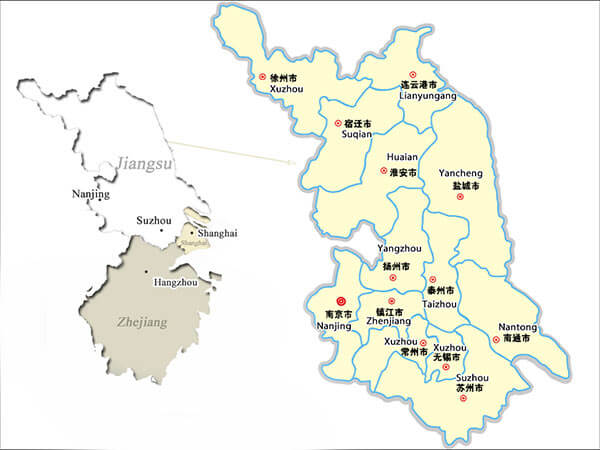
Heavy industry products & technology products
Mechanical and electrical products
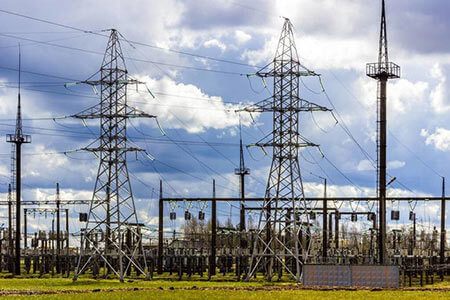
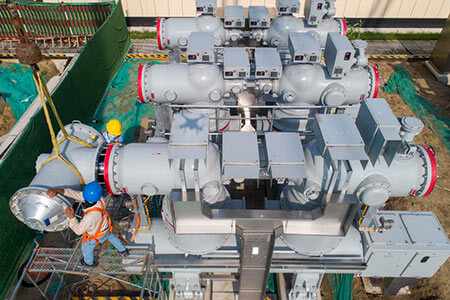
The range of mechanical and electrical products is very broad, including mechanical equipment, electrical equipment, transportation, electronic products, electrical products, instrumentation, metal products and so on.
Jiangsu’s integrated circuit industry ranks first in the Yangtze River Delta, especially in Wuxi, Jiangsu. Jiangsu’s exports of mechanical and electrical products account for more than half of Jiangsu’s total exports, mainly to the United States, ASEAN, Hong Kong, Japan and South Korea.
Automobiles
There are more than 2,500 automobile enterprises in Jiangsu, and the scale of auto parts production ranks first in China. Jiangsu also has large-scale production of new energy vehicles and related products, and is currently the largest power battery producer in China. The production areas are mainly distributed in Suzhou and Wuxi.
Biomedical products
Jiangsu’s biomedical industry has an annual output value of more than US$70 billion, ranking first in China, half of which comes from the pilot free trade zones in Suzhou, Nanjing and Lianyungang, which are home to more than 4,000 biomedical enterprises and a complete cluster of upstream and downstream industrial chains.
Chemical fiber
Jiangsu’s chemical fiber output is second only to Zhejiang Province, and the production enterprises are generally concentrated in Suzhou, Wuxi and Nantong. Polyester, nylon and viscose staple fiber are the most produced.
Daily Products
Textile and garment
Jiangsu’s textile and garment industry has a long history of development, and is one of the birthplaces of China’s textile industry, which has founded many famous clothing brands such as Bosideng and Heilan Home, and currently has more than 2,500 fabric production enterprises. Garment production accounts for 1/10 of the country. Changshu, Jiangsu is a well-known garment production base.
Plastics
Jiangsu ranks among the top three in China’s plastics industry in terms of output, with a complete range of plastic production, and Jiangsu Province has the largest number of plastic packaging manufacturing enterprises.
Furniture
Jiangsu’s furniture industry ranks among the top three in China, with a annual furniture output of more than 17 billion pieces and nearly 10,000 furniture enterprises, mainly distributed in Nantong and Suzhou. The largest furniture base in eastern China, Chengdong Town in Hai’an, is located in Nantong, where there are many furniture factories.
These are the main industrial clusters of Jiangsu cities.
| Changzhou | Automotive parts, face masks |
| Nantong | Home textiles, furniture |
| Wuxi | Electric vehicles, steel and metal plates, textile and clothing products (such as knitwear) |
| Suzhou | Fabric materials, textile and clothing products (such as sweaters, down jackets), maternity and baby products |
| Xuzhou | Electric two-wheeled vehicles, construction machinery |
| Yangzhou | Toothbrushes, automotive parts and components, mechanical equipment |
| Zhenjiang | Home textiles, eyeglasses |
| Lianyungang | Crystal products, seafood |
Zhejiang
Zhejiang’s main exports include electrical and mechanical products, clothing, textiles and other high-tech products, which are generally exported to the European Union, the United States, ASEAN, Japan and Russia. Zhejiang’s Yiwu China Commodity City is China’s premier specialty market for small commodities and a prestigious international sourcing center.
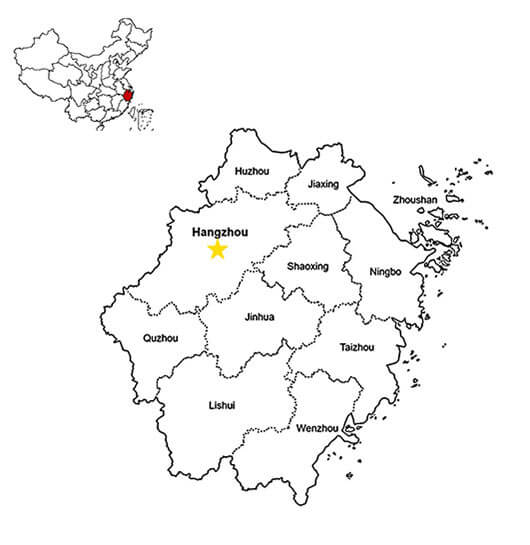
Heavy industry products & technology products
Machinery and Electrical Products
Machinery and electrical products are the most crucial exports in the region, with an export value roughly three times that of textile and clothing. Different cities in Zhejiang specialize in various types of production – for instance, Jinhua is known for manufacturing cars and their components, Ningbo focuses on electrical machinery and equipment, while Wenzhou primarily produces electrical appliances, instruments, and meters.
Artificial Intelligence
In Zhejiang province, the artificial intelligence industry is mainly concentrated in Hangzhou, Ningbo, Wenzhou, and Shaoxing. The products include facial recognition, facial editing, wide-image recognition, smart customer service, autonomous driving, and more. These kinds of products find extensive applications in fields like healthcare, unmanned retail, smart connected cars, and intelligent household appliances.
Chemical Fibers
Chemical fibers play a vital role as raw materials in textile products, and Zhejiang province ranks first in China’s annual chemical fiber production. Many chemical fiber manufacturers are scattered across cities like Hangzhou, Shaoxing, and Jiaxing, accounting for approximately half of China’s total chemical fiber production.
Daily Products
Textile and Apparel, Furniture



Zhejiang province is renowned in China for its textile and apparel industry. There are many famous textile hubs within the province, such as Lanting Town in Shaoxing known for knitting, Datang Town in Zhuji renowned for socks, and Heshan Town in Tongxiang known for silk production.
The main textile products in Zhejiang include fabrics, various types of clothing, socks, ties, and more. The furniture production here ranks among the top in China, making it the largest furniture manufacturing hub in the country, home to leading companies like Kuka Home and Henglin Group.
Plastics
Zhejiang province takes the lead as China’s largest producer of plastic films, contributing to around 22% of the national plastic film production. Additionally, plastic packaging products are also produced in large quantities, including everyday plastic packaging, industrial plastic packaging, and plastic packaging for electronic materials, offering a wide variety.
Paper
Zhejiang’s paper industry ranks in the top five in China, accounting for over 10% of the country’s total paper production. The major production areas are Jiaxing, Ningbo, and Quzhou.
These are the main industrial clusters of Zhejiang cities.
| Hangzhou | Artificial Intelligence, Textile and Apparel, Chemical Fibers |
| Ningbo | Textile and Apparel, Paperboard, Electrical Appliances, Integrated Circuits, Plastics |
| Yongkang, Jinhua | Metal Products, Electrical Appliances, Automotive Components, Doors |
| Yiwu, Jinhua | Various daily-use products, sports and outdoor products, and more |
| Shaoxing | Textile and Apparel, Umbrellas, Chemical Fibers |
| Jiaxing | Paperboard, Computer Electronics, Chemical Fibers |
| Wenzhou | Shoes, Packaging Materials, Machinery and Electrical Products |
| Quzhou | Paperboard, Mechanical Equipment |
| Taizhou | Plastic and Rubber Products, Molds |
| Huzhou | Textile products, Cosmetics |
Anhui
Anhui is rich in mineral resources, with a focus on heavy industries. The main exported products from Anhui include cars, home appliances, textiles, steel, and rubber products.
Automobiles
Anhui is home to various car manufacturers such as Chery, NIO, Volkswagen, BYD, and more than 1,200 supporting companies. In recent years, the car production in Anhui has been rapidly growing. By 2023, the province’s car production surged to the second-highest in the country, with the second-highest export quantity. The production of new energy vehicles reached 780,000 units, ranking fourth in China.
Lithium Batteries
Lithium batteries are environmentally friendly, with high energy storage capacity, and are indispensable power sources for devices like phones, computers, cars, and outdoor lighting. Driven by the new energy industry, Anhui’s production and export of lithium batteries are continually growing, with Europe and America being the major export destinations.
Home Appliances
Anhui serves as a manufacturing hub for many well-known home appliance companies. As early as 2011, Anhui’s production of three major categories – refrigerators, washing machines, and air conditioners – ranked second in China. Among them, the refrigerator production claimed the top spot in China, washing machine production surpassed the Pearl River Delta and the Bohai Sea region, and air conditioner production was second only to the Pearl River Delta.
4. What are the big ports in the Yangtze River Delta?
The Yangtze River Delta port cluster can be roughly divided into three parts: Shanghai, Jiangsu, and Zhejiang, each having its own ports. The main seaports include Shanghai Port, Lianyungang and Dafeng Port in Jiangsu, and Ningbo-Zhoushan Port and Wenzhou Port in Zhejiang.
Shanghai Port

Shanghai Port is a crucial hub along China’s coastline, ranking as the world’s second-largest port with the highest container throughput globally. It operates over 300 international shipping routes, facilitating the transportation of goods to destinations worldwide.
The main cargo categories handled include containers, coal, metal ores, petroleum and its products, steel, construction materials, machinery, and equipment.
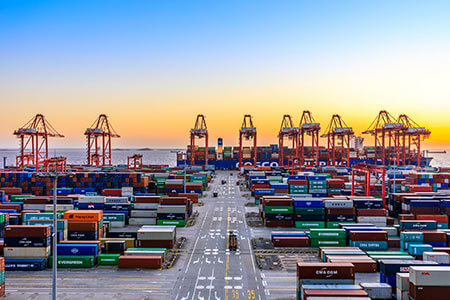
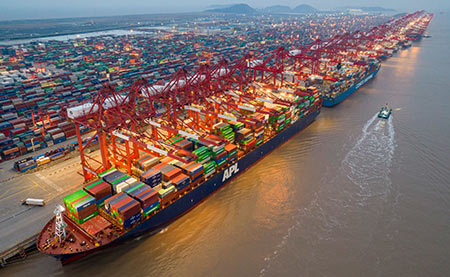
Shanghai Port encompasses numerous port areas, with Yangshan Port being the largest deep-water port currently, handling half of Shanghai Port’s total container throughput.
Established in 1991, the Waigaoqiao Port Area, predating the completion of Yangshan Port, used to be the largest container deep-water port in Shanghai. It primarily serves international transportation, focusing on container and oil transport while also accommodating bulk and general cargo shipments.
Ningbo Zhoushan Port
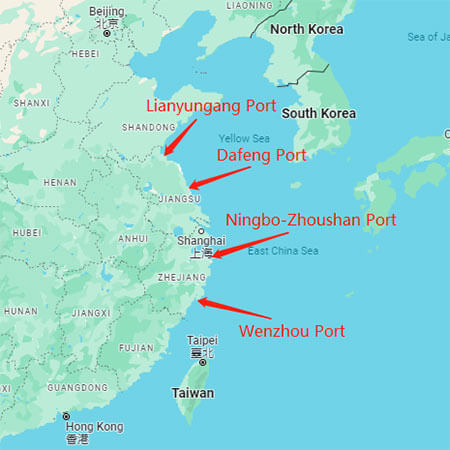
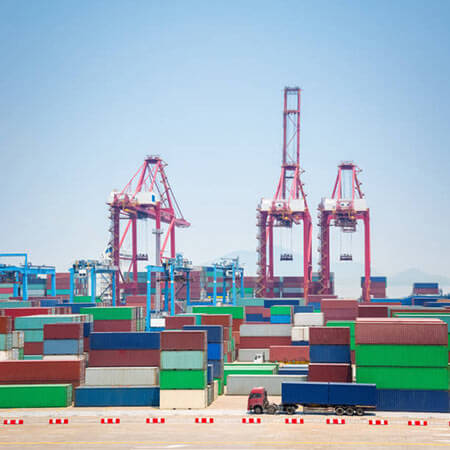
Ningbo-Zhoushan Port, formed by the merger of Ningbo Port and Zhoushan Port, stands as the world’s largest port in terms of cargo throughput. With nearly 170 berths capable of handling vessels exceeding 10,000 tons, it accommodates the distribution of super-large ships.
The container throughput of Ningbo Port ranks third globally, boasting over 300 container routes connecting with over 600 ports in 100-plus countries and regions worldwide. The port handles a variety of goods, including containers, ores, crude oil, liquid chemicals, grains, and coal.
Ningbo-Zhoushan Port consists of 19 port areas, with commonly used ones for container shipping being Beilun Port Area, Chuanshan Port Area, Daxie Port Area, Meishan Port Area, and Jintang Port Area. Port areas specializing in bulk and general cargo transport include Beilun Port Area, Chuanshan Port Area, Liuhen Port Area, and Cengang Port Area.
Lianyungang Port


Lianyungang Port, located in the northeast of Jiangsu Province, is one of China’s most crucial ports for international trade and transportation.
Goods such as coal and raw materials from China’s central and western regions, as well as some Central Asian countries, are frequently shipped through Lianyungang to destinations like Europe, the Persian Gulf, Australia, Singapore, South Korea, Japan, Hong Kong, and other countries and regions.
Lianyungang Port has 85 berths capable of handling vessels exceeding 10,000 tons, with the largest deep-water berth accommodating ships up to 400,000 tons. The annual cargo throughput exceeds 300 million tons.
Furthermore, Lianyungang Port operates 86 container routes, 29 general cargo roll-on/roll-off routes, 2 China-Korea passenger and cargo ferry routes, and 6 international rail routes.
The port comprises 5 port areas, with Lianyungang Port Area serving as the main area, specializing in the transportation of containers and bulk cargo while also accommodating passenger and general cargo transport.
Wenzhou Port
Wenzhou Port, located in the southern part of Zhejiang Province, handles an annual cargo throughput of nearly 90 million tons. Among this, foreign trade throughput exceeds 5 million tons, with major goods including coal, petroleum, metal ores, steel, cement, and grains. Wenzhou Port engages in trade with countries such as Japan, South Korea, Kuwait, Russia, Singapore, and North Korea.
Zhongyangao Port Area is the primary deep-water port, and it has established 10 ocean routes to destinations like the Philippines and Vietnam, as well as a route to Russia.
Yancheng Port
Yancheng Port is situated in the central coastal region of Jiangsu, handling a cargo throughput of over 100 million tons.
The port has four sea harbors, with Dafeng Port being the most crucial for foreign trade. Dafeng Port benefits from its strategic location, boasting a natural deep channel with a normal water depth of around 15 meters, remaining ice-free throughout the year.
It primarily focuses on transporting containers, bulk and general cargo, grains and oils, petrochemicals, and roll-on/roll-off shipments of automobiles. It frequently engages in trade with countries like Japan, Russia, and South Korea.
Nantong Port
Nantong Port, operational since 1980, is located in the eastern part of Jiangsu Province. Serving as a vital transportation hub for both domestic and international trade, it specializes in transporting bulk cargo from the Jiangsu region and the upper and middle reaches of the Yangtze River.
Currently, it has established navigation connections with over 300 ports in more than 100 countries and regions, including Japan, the United States, Europe, and Hong Kong. Among the port areas, Yangkou Port Area and Lusi Port Area are the major seaports.
The end
The Yangtze River Delta is one of the three major economic zones in China. If you want to know more articles about China’s economic regions, you can click here.
If you’re interested in importing from China, contact us at Jingsourcing. We are very experienced in finding suppliers and have helped more than 4,000 customers find the suppliers they need. We can help you throughout the entire procurement process.

I want to express my appreciation for the writer of this blog post. It’s clear they put a lot of effort and thought into their work, and it shows. From the informative content to the engaging writing style, I thoroughly enjoyed reading it.
Its like you read my mind You appear to know so much about this like you wrote the book in it or something I think that you can do with a few pics to drive the message home a little bit but instead of that this is excellent blog A fantastic read Ill certainly be back